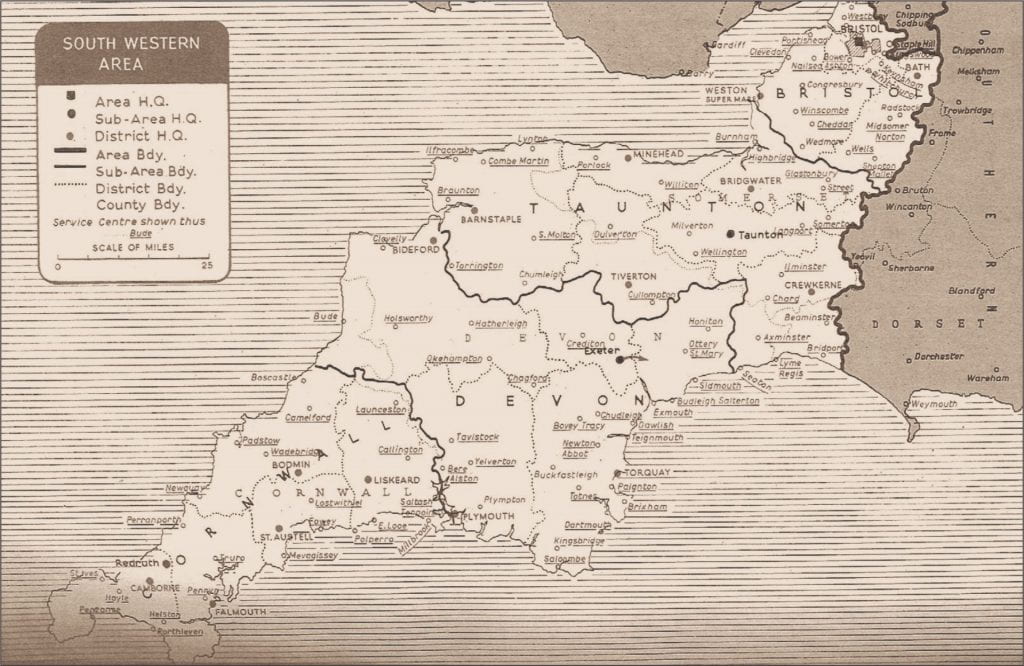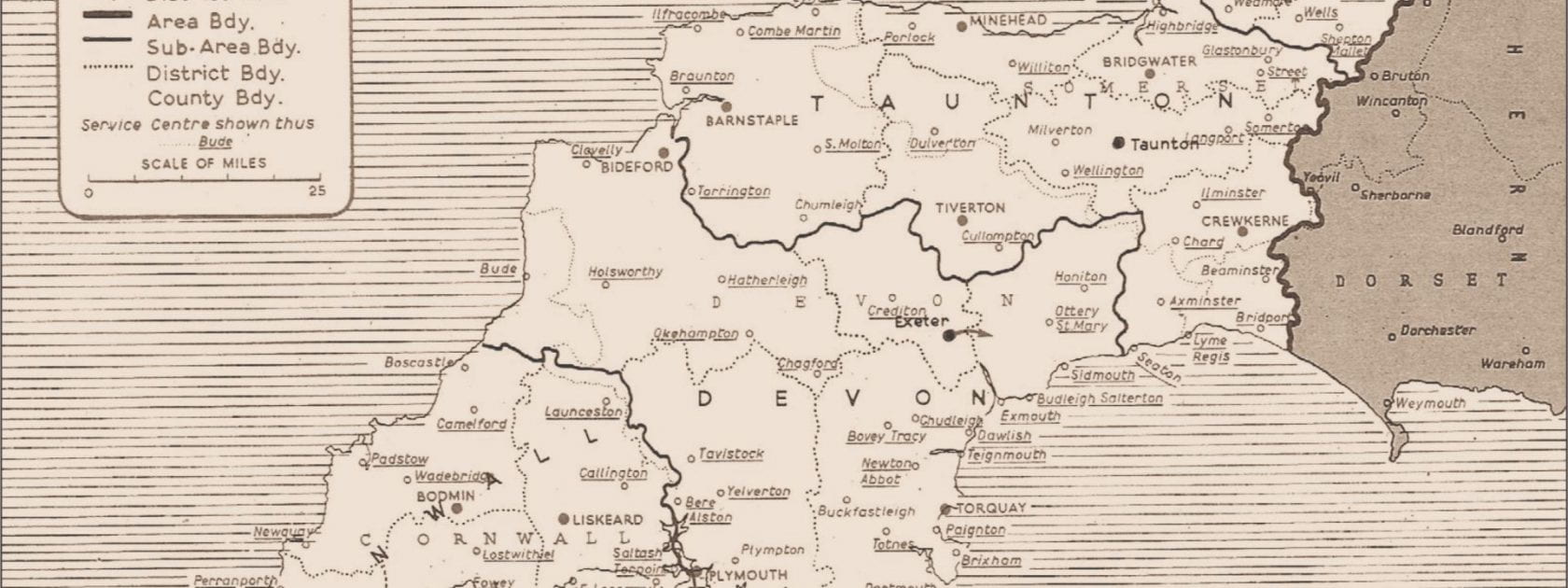III Nationalisation
After three decades of discussion the whole organisation of electricity was restructured following the Electricity Act 1947. From 1 April 1948, the South Western Electricity Board took over the distribution assets of eleven local authorities and 28 companies (Figure 1). The generating stations and the transmission lines of the Central Electricity Board were transferred to the British Electricity Authority.

Electricity Distribution
The SWEB was responsible for integrating the 39 undertakings. An early scheme was the extension of the 33kV distribution network.[33] Systems had to be standardised and the multiplicity of tariffs reduced. For administrative purposes, the Board area was subdivided five sub-areas and 22 districts.[34] Initially the districts tended to reflect the pre-nationalisation company and municipal areas. The SWEB area was extended to the Scilly Isles in 1958 when the small St Mary’s undertaking was transferred to the Board by the CEGB.[35]
Figure 5 shows the geographical organisation in 1957 when there were four sub-areas and 19 districts. One notable feature is the network of 113 service centres where consumers could pay their bills and purchase appliances. These service centres were an important and profitable part of the Board’s business.[34]
The SWEB’s first decade of operation coincided with a major phase of growth in demand in all segments of the market. Between 1948/9 and 1958/9 the number of consumers rose from 531,000 to 754,000 and sales increased from 1,173 m kWh to 2,966 m kWh.
Electricity Generation and Transmission
The South Western Division of the British Electricity Authority covered the area of the SWEB together with part of Gloucestershire. It was an amalgamation of the 132 kv transmission system developed by the Central Electricity Board and the power stations previously owned by companies and local authorities. The main tasks from 1948 were to integrate the various generating stations and their workforces, to modernise and standardise operations, and to expand capacity to meet the rapidly growing demand.
Table 7 shows the 27 power stations in the new organisation. They varied in size from large turbine-powered stations at the top to small diesel-engined and hydro units at the lower end of the table. A comparison with Table 4 shows that most of the growth in capacity after 1935/36 had been concentrated at four selected stations—Portishead, Plymouth, Newton Abbot and Hayle. One new station at Castle Meads, Gloucester had been built in 1942 to cope with wartime demand.
Within a decade, most of the objectives planned in the late 1940s had been fulfilled. Except for the hydro stations at Mary Tavey, Morewellham and Chagford, all the small stations had been shut down. One existing station, at Hayle, had been extended in 1948 and 1959 and three new stations at East Yelland (1953-58), Plymouth B (1952-1960), and Portishead B (1955-59) had been completed. These would be the last conventional steam stations in the South West. By the time the last 60,000 kW turbine unit had been installed at Plymouth, much larger units were in service at new stations in the coalfield area of the East Midlands.[35] Between 1948/9 and 1958/9 the number of power stations in the South West had been reduced from 27 to 13 while the generating capacity had been doubled (Table 8).
Some changes were also made to the 152 kv transmission grid. A new line connected East Yelland power station to the 1930s grid at Fraddon and near Taunton. Additional supply points to the SWEB were constructed at Axminster, Churchill (for North Somerset), Lockleaze (North Bristol) and Ryeford (Stroud).
Table 7 British Electricity Authority Power Stations in the South Western Division 1948/49
By the late 1950s some results of new expansion plans for the grid and generating capacity were beginning to show in the landscape. Since the existing national transmission grid was limited in capacity, especially for interregional transfers of power, a new Supergrid at 275 kv was being developed. A line from Melksham to Pyle in South Wales was under construction in 1959 and the tall towers for the Severn crossing at Aust and Benchley Point had been completed. Another 275 kv line from Melksham to Exeter was in the planning stages. New generating technology in the form of nuclear reactors was being introduced, with new power stations at Berkeley and Hinkley Point. These were approved in 1957 and construction was underway. Berkeley opened in 1962 and Hinkley Point in 1965.
Table 8 Central Electricity Generating Board Power Stations in the South Western Division 1958/59
From January 1958, when the Central Electricity Generating Board took over from the Central Electricity Authority, there were changes in the administrative structure. A new South Western Region was established incorporating the Southern, South Western and South Wales Divisions. Under the new arrangements the regional director became responsible for the higher-order planning and administration of 43 power stations, 1,768 miles of transmission lines and 8,979 employees. The divisions were retained for a few years before operational management became more centralised. Design work was transferred to new project groups. Bristol retained its position in the new administrative system with new offices added to the existing complex of buildings and the 1930s Grid House in Oldfield Road, Clifton.
[33] The SWEB First Annual Report 1948-49 includes a map of main distribution lines (Appendix C).
[34] Map of administrative areas, Appendix B in First Annual Report. For details of administrative organisation: see Peter Lamb, “SWEB Chronology, 1948-1990,” Histelec S28, 2004, and Peter Lamb. “SWEB Central Accounting Office (CAO),” HIstelec S4, 2013. This paper documents the centralisation of accounting in Plymouth.
[35] Central Electricity Generating Board, Annual Report 1958-9, p.10.
[36] David Cousins and Peter Lamb, “SWEB’s commercial success,” Histelec S61, 2015.
[37] Castle Donington had 100,000 kW units from 1956 and the first 200,000 kW turbine was installed at High Marnham in 1959.


